Living on the streets of California is a deadly affair. The life expectancy of an unsheltered person is 50, according to national estimates, nearly 30 years less than that of the average Californian. As homelessness spirals out of control throughout the state, so too do deaths on the street, but it’s those whose lives are the most fragile who are least likely to get medical care.
How Street Medicine Teams Are Tackling the Unhoused Health Care Crisis
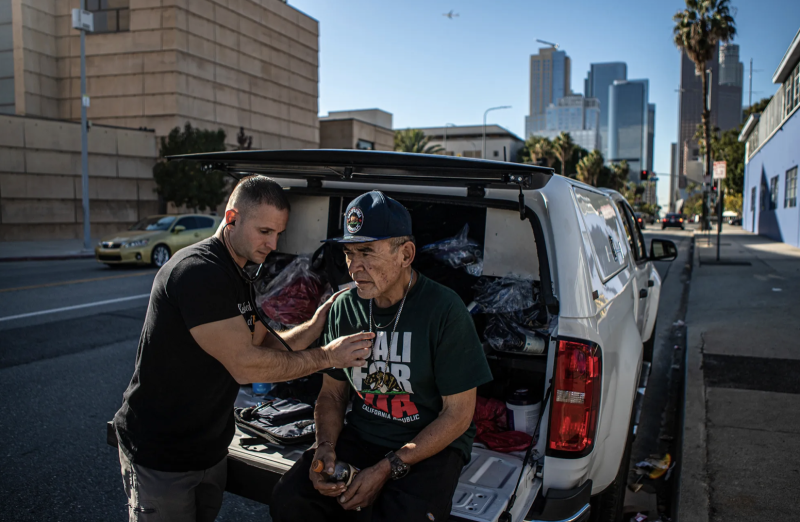
Now, the state Medi-Cal agency is endeavoring to improve health care access for people experiencing homelessness. Through a series of incentives and regulatory changes, the Health Care Services Department is encouraging Medi-Cal insurers to fund and partner with organizations that bring primary care into encampments.
They’re known as street medicine teams. There are at least 25 in California.
“Oh, crap. This is where she was, and they just swept that,” said Brett Feldman on a Friday morning in November, looking at a green tent, crumpled and abandoned on Skid Row in Los Angeles. Feldman, a physician assistant, is searching for a female patient in her 40s with severe and unmanaged asthma. She cycles predictably in and out of the hospital, and Feldman knows she’s due for another hospitalization soon.
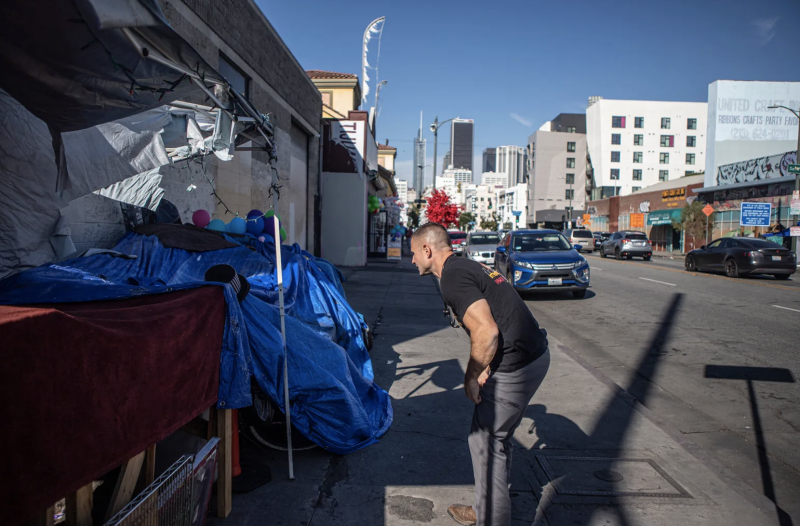
The road is streaked with water from a cleaning truck, and sanitation workers in fluorescent vests sweep up debris. Parking enforcement and police cruisers line the section of road where a homeless encampment once stood. Nearly 5,000 people live in the half-mile block infamous for the hypervisibility it affords the state’s unrelenting homelessness crisis.
Burdened by disproportionate rates of substance use disorders, mental health disorders and chronic disease, people experiencing homelessness are some of the state’s neediest patients, but few receive anything more than emergency services. Barriers like lack of transportation and cumbersome insurance rules keep most from getting regular health care. Instead, they drift through the emergency room during a crisis, racking up high costs to the system (PDF) and deteriorating physically in the interim.
Delivering health care this way is costly and not particularly effective for the patient or the system. More than half of the state’s $133 billion Medi-Cal budget is spent on the top 5% of high-needs users (PDF), according to the California Department of Health Care Services.
“Where we have been falling short, especially with this population, is their reality is so different from ours that we haven’t been building reality-based systems for them,” Feldman said. “They have Medi-Cal. They’re eligible for all these benefits, but they can’t access these benefits.”
The state’s efforts to bridge the gap between eligibility and access is supported in part through CalAIM, a multiyear plan to revamp the state’s lower-income health insurance program. Grants to hire staff or invest in billing or data collection software offer some stability to teams that have historically been volunteer- or charity-operated. The department also issued a rule change in November allowing street medicine teams to tap into and manage unhoused patients’ Medi-Cal benefits (PDF), meaning providers can be reimbursed for their work.
“One of our core principles of CalAIM is breaking down the walls of health care and meeting people where they are,” said Jacey Cooper, director of the state’s Medi-Cal program. “We really feel like street medicine helps us do that.”
What is street medicine?
Several months ago, Feldman’s Skid Row patient suffered a brain injury from lack of oxygen during an asthma attack. She’s now confined to a wheelchair and reliant on a friend for basic needs like finding food and using the toilet.
Newer asthma medications might be able to help end her hospitalization cycle, but until recently only her assigned primary care doctor, whom she has never seen, was allowed to refer her to a specialist for assessment under Byzantine Medi-Cal rules. Feldman had been trying to get her a primary care appointment for more than a year, to no avail.
Under the new rules, however, Feldman could have referred the asthmatic patient directly to the lung specialist she needed or gotten prior authorization for the medication since it was recommended during a hospital stay. Instead, without adequate medical care to address her condition, her life has been irrevocably altered.
Statistically, she’ll be lucky to live longer than a few more years.
“She used to be a staple down here. She knew everybody,” Feldman said. “Now, she can’t walk, is confined to her tent. She’s lonely because she’s used to being part of the Skid Row community. She had a very full life despite being unhoused.”
Feldman, co-founder and director of the street medicine program at the University of Southern California’s Keck School of Medicine, said the goal of street medicine is to give some autonomy back to people who usually have very little power left in their lives.
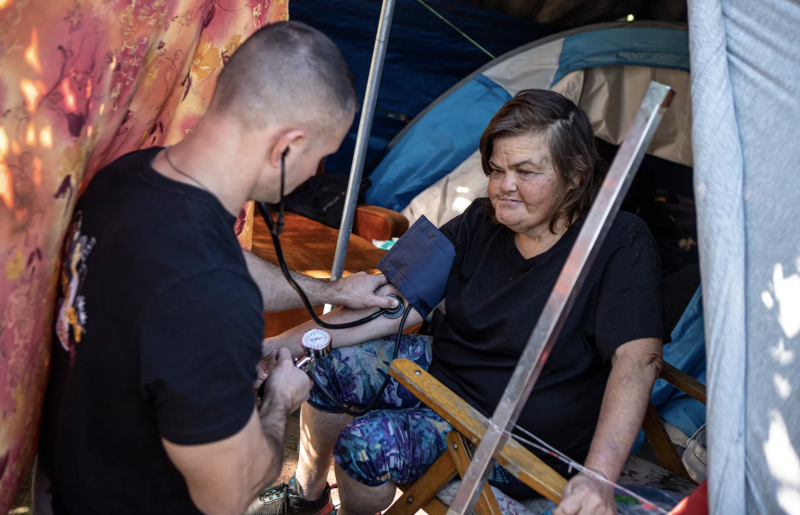
Each day he and a team of providers scour the county streets diagnosing chronic and acute conditions, treating mental illness and substance use, delivering medicine, drawing blood for tests and following up with patients who request a visit. Community health workers hand out food and hygiene supplies and help them navigate hurdles as they try to obtain housing and social services.
“We know that people who are experiencing homelessness have higher mortality, have higher ER utilization, have higher length of stay when they get admitted,” Cooper said. “We really see this as part of a comprehensive approach to ensuring that we have a true continuum of care for people experiencing homelessness.”
The traditional health care system thrives off efficiency: The more patients move through an office, the more the provider gets paid, resulting in brief appointments and little sympathy for circumstances that make patients late. But that setup doesn’t work for unsheltered people who run the risk of getting their belongings stolen if they leave their camp — or who would rather find something to eat than take care of what may seem like a minor malady.
Less than 30% of unhoused people with Medi-Cal have ever seen their primary care provider, according to a state legislative analysis of a street medicine bill vetoed by Gov. Gavin Newsom in 2021. The measure passed the Legislature with broad support but was opposed by the state Health Care Services Department for potential duplication of services. In the veto (PDF), Newsom directed the department to work with street medicine teams to fill any gaps left by CalAIM; one such gap was adjusting billing codes that prevented street medicine reimbursement.
“When you’re focused on those very basic needs, like food, safety, shelter, how are you then able to focus on, you know, managing your diabetes or your blood pressure or some of these risk factors that can lead to more serious downstream effects?” said Dr. Kyle Patton, medical director of the street medicine program at Shasta Community Health Center in Redding.
On a Monday in September, Patton and Anna Cummings, a case worker, trekked through a wooded area on the north edge of town to meet Amber Schmitt, 47, a patient with an infected leg. The ground is muddy from a storm the night before. Schmitt is paying a friend $700 a month to stay in his apartment, but hidden among the trees and rolling hills is her abandoned encampment, along with dozens of others. Schmitt gets $1,000 a month from Social Security, but it’s not enough to afford a security deposit or rent in the area, she said.
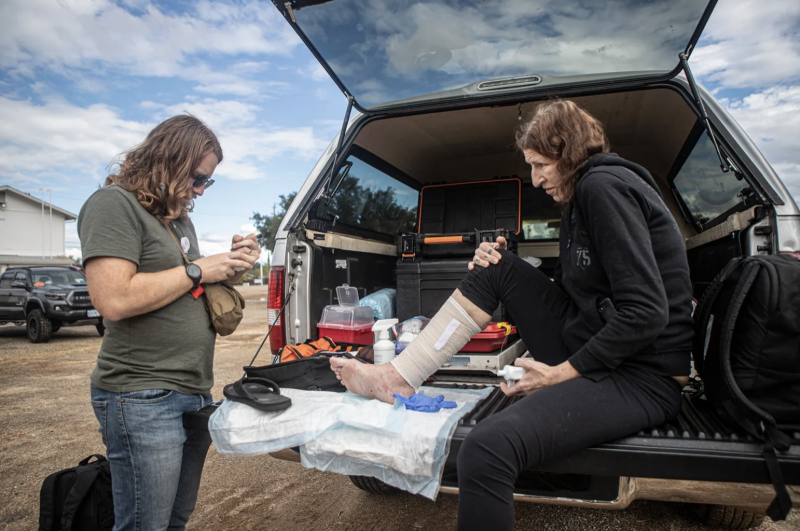
The gash on Schmitt’s right shin is mottled and inflamed. She said she scraped it on a fallen branch. Patton cleaned and dressed it for her previously, but she had no choice but to reuse bandages after running out. Now she can barely walk from the pain.
“This is a silver-based dressing, which will kill bacteria in wounds,” Patton tells Schmitt after rinsing the area with a saline wash. “We’ll get you some more dressing, too. And then you’ve got some skin breakdown and maceration between your toes. I don’t like the look of that.”
He gives her a fungal cream and a bottle of antibiotics. Schmitt is a leukemia survivor and has had a hip replacement on the same injured leg. Her medical history makes her prone to infections and poor circulation in her extremities, Patton said.
“There’s people that would maybe make the argument that … they have health insurance here in California, they should just utilize the system as-is. The reality is because of certain factors within the context of their homelessness, they’re not able to do that,” Patton said.
Although they qualify for comprehensive health coverage under Medi-Cal, the program wasn’t necessarily designed with unhoused people in mind. For example, Medi-Cal will pay for transportation to and from a doctor’s appointment, but it requires the patient to provide a fixed address and give several week’s notice to the driver, something most people experiencing homelessness aren’t able to arrange.
Link between homelessness and health
Health data on unhoused people is sparse, with no state agency and only a handful of counties tracking the information, but it’s clear that most of their deaths are preventable.
In Alameda (PDF) and Marin (PDF) counties, half result from acute or chronic health conditions like cardiovascular disease, cancer or respiratory failure. In Orange County, these make up a quarter of deaths among the unhoused. In Los Angeles County, heart disease is the second-leading cause of death among people experiencing homelessness, second only to overdoses.
Even overdose deaths are considered preventable — yet in San Francisco, overdoses cause 82% of deaths among the unsheltered.
“We commonly see conditions that you would see in a typical population, but they’re just not addressed. So, out-of-control high blood pressure, uncontrolled diabetes … also substance use in terms of opioids, we see a whole lot more than in the general population,” said Dr. Absalon Galat, medical director for LA County’s Department of Health Services’ Housing for Health division.
Galat’s team started its foray into street medicine in an effort to dole out COVID-19 vaccines, but team members quickly found they needed to do more. The county used COVID-19 relief funds to purchase mobile clinics, and CalAIM funding has helped them hire 60 staff members.
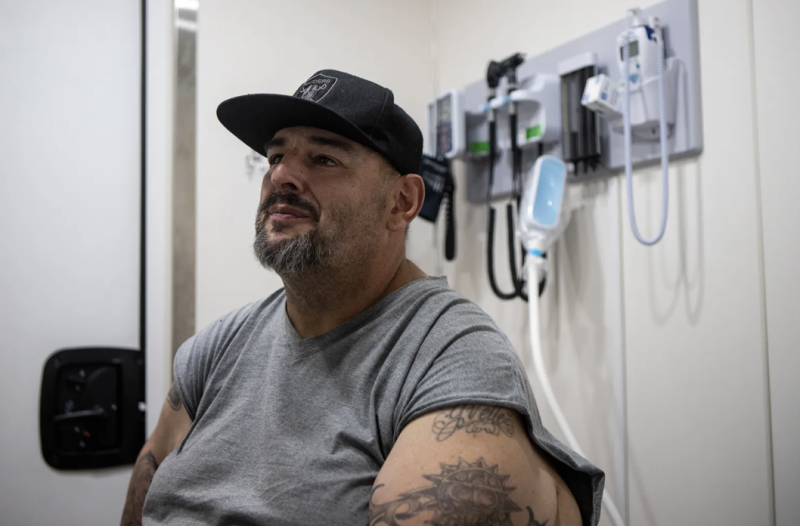
In September, the county’s fleet of mobile clinics, complete with fully outfitted exam rooms, began visiting areas where services are sparse. Smaller teams of clinicians and case workers roam encampments to follow up with patients, treat minor issues and bring patients to the mobile clinic. There’s some disagreement among street medicine providers about whether mobile clinics remove enough barriers because they still require patients to travel to a set location, but Galat said his goal is to improve access, whether it’s by wheel or foot.
“People are dying every day,” Galat said. “So we have to try with what we know best in the medical field right now to limit people who are dying.”
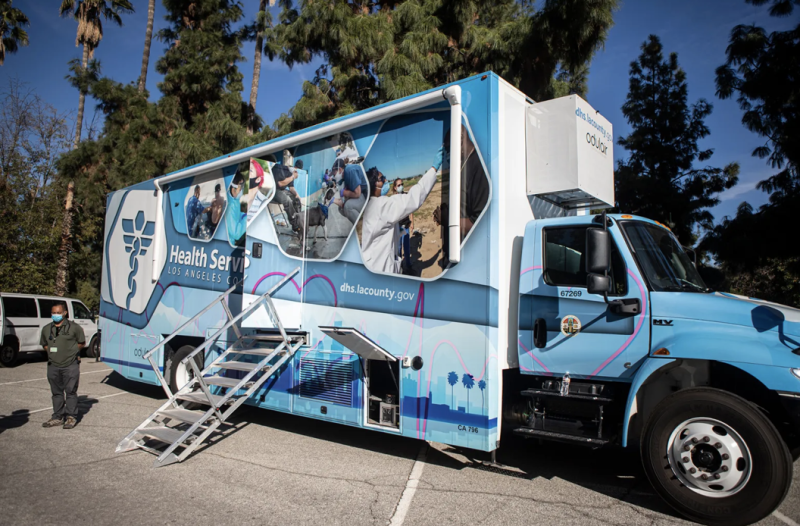
The connection between homelessness and health is inextricable, said Dr. Michelle Schneidermann, director of the People-Centered Care team at the California Health Care Foundation, a statewide health policy think tank.
“Either one can lead to the other. A catastrophic health incident or a series of conditions can lead to someone not being able to work, leading to poverty,” Schneidermann said. “We see this all the time, health conditions precipitating homelessness, and the other way around.”
Take Danny Doran, 56, who visited LA County’s mobile clinic at Whittier Narrows Park on a recent Thursday to pick up insulin. He spent his career as a plumber and owned a home in Bishop. Three years ago he fell into a diabetic coma and was hospitalized for months. A friend Doran trusted to pay his bills while he was hospitalized emptied his bank account and disappeared — Doran has been unhoused ever since. Several weeks ago he was beaten and robbed by another unhoused man, who left him with a fracture in his skull and a tremor in his hands.
“I guess I’m a little bit naive,” Doran said. “We’re all humans and we’re prone to mistakes, you know? So I hate for anyone to have their money stolen like mine was and end up like me on the streets.”
At the mobile clinic, Doran said the doctor on staff agreed to be his primary care physician. His previous primary care doctor stopped accepting Medi-Cal insurance, and Doran hasn’t had regular access to insulin ever since.
“The doc here, she truly has compassion for her patients. I’m glad our paths crossed,” Doran said.
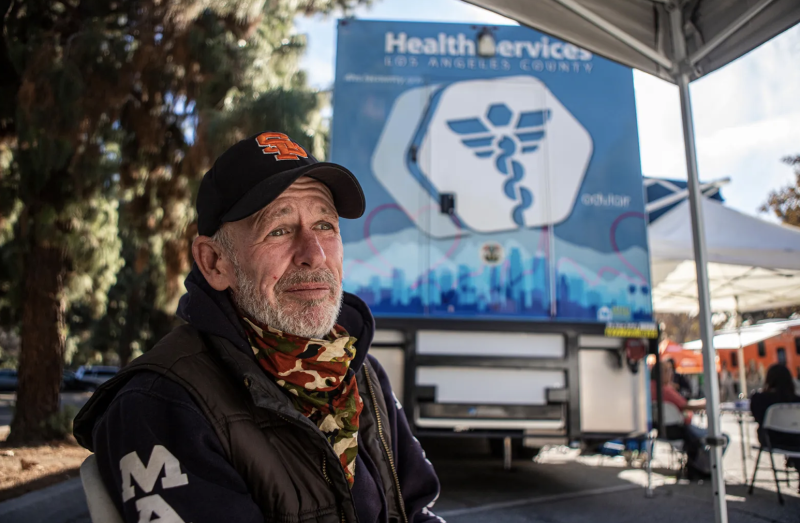
Schneidermann, who is overseeing a study on street medicine programs across California, said CalAIM, which also pays for housing services, is an opportunity for the state to address its most pernicious problem.
“Until we can end our crisis of homelessness … we have to find a way to deliver care for people on the streets,” Schneidermann said.
New programs popping up
Prior to CalAIM and the Health Care Services Department’s rule changes, street medicine programs operated outside of traditional health care, funded by philanthropies or the rare health organization willing to lose money. Now, the department’s changes offer some hope for stability, Feldman said.
Noting that these programs were birthed out of the pandemic, Feldman said they “might not exist in a few years if they’re not supported, but they have all these patients that rely on them.”
A year ago only 25 programs existed across the state, primarily concentrated in urban areas, Feldman said. But ever since CalAIM launched at the beginning of 2022, he’s run into more organizations looking to begin services. CalAIM requires Medi-Cal insurers to coordinate patients’ physical, behavioral, dental and developmental care as well as social services — something many street medicine teams already do. The goal is to make the “system hustle behind the scenes rather than making the patient hustle,” California Health Care Foundations’ Schneidermann said.
One such program is run by Anthony Menacho in Sacramento. Unlike USC, Shasta Community Health or LA County’s teams that are staffed full-time, Menacho’s street medicine band is composed entirely of volunteers. They visit six camps every other weekend.
The work was funded initially by a $100,000 grant from Health Net, the largest Medi-Cal provider in the state, but Menacho, who trained as a physician assistant with Feldman at USC, wants to be able to do the work full-time and hire more clinicians. He’s working to secure money through CalAIM and the Department of Health Care Services.
“We don’t have the academic resources or people behind us to be able to put in a department or infrastructure on the drop of the dime,” Menacho said. “We run on grants, but that’s not true sustainability. We can’t do it ourselves. It has to be a coordinated effort and I think that’s what CalAIM is trying to do.”
